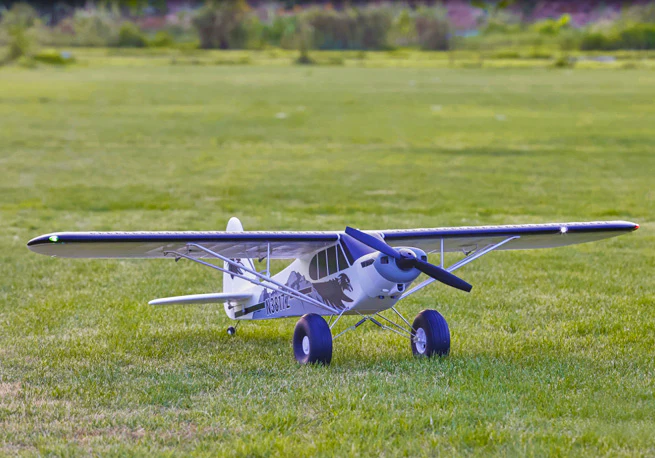Understanding FMS: The Future of R/C Flying

FMS, or Flight Management System, represents a transformative approach to remote-controlled aviation that has captivated enthusiasts worldwide. Originally developed as a free flight simulator software, FMS has evolved into a comprehensive platform that helps pilots master complex maneuvers and aircraft handling before taking to the skies with actual models. This digital training ground has become essential for anyone serious about R/C flying, offering realistic physics and diverse aircraft options.
The R/C flying community has experienced remarkable growth in recent years, with thousands of hobbyists discovering the thrill of piloting scale aircraft and performing breathtaking aerobatic routines. From gentle trainers to aggressive 3D flyers, the variety of available aircraft has sparked unprecedented interest in developing piloting skills that were once reserved for experienced veterans.
As the hobby becomes more sophisticated, pilots need reliable resources to advance their abilities safely and efficiently. The FMS website serves as a central hub where rc beginners can learn fundamental techniques without the risk of costly crashes, while experienced pilots can refine advanced aerobatic sequences and connect with like-minded enthusiasts who share their passion for precision flying.
The Evolution of R/C Flying
Remote-controlled aviation traces its roots back to the 1930s, when pioneering hobbyists first experimented with radio signals to control model aircraft. These early attempts were crude by modern standards, relying on single-channel systems that could only manage basic rudder control. Pilots had to master the delicate balance between throttle settings and wind conditions, making successful flights rare achievements that drew crowds of amazed spectators.
The post-war era brought significant technological advances that transformed R/C flying from an experimental curiosity into a legitimate hobby. Transistor technology replaced bulky vacuum tubes, making radio equipment lighter and more reliable. By the 1960s, multi-channel proportional control systems emerged, allowing pilots to command aileron, elevator, rudder, and throttle independently. This breakthrough opened new possibilities for realistic flight patterns and laid the foundation for the sophisticated aircraft we see today.
The introduction of computer-aided design and lightweight composite materials in the 1980s revolutionized aircraft construction. Foam technology made planes more durable and affordable, while electric motors began challenging the dominance of nitro engines. These innovations democratized the hobby, bringing R/C flying within reach of average enthusiasts rather than just dedicated craftsmen with workshop facilities.
Aerobatic flying emerged as a distinct discipline during this period of rapid development. Pilots discovered that purpose-built aircraft could perform maneuvers impossible in full-scale aviation—hovering, torque rolls, knife-edge flight, and dramatic tumbling sequences. The 3D aerobatics movement transformed R/C flying into a performance art, where skilled pilots could make aircraft dance through the air with precision that defied conventional aerodynamics. Today’s R/C community encompasses everything from scale warbirds and gliders to extreme aerobatic machines, creating a diverse ecosystem where every flying style finds passionate advocates. Manufacturers like FMS Model have contributed to this growth by producing ready-to-fly aircraft that combine quality construction with accessible pricing, making it easier for newcomers to enter the hobby with reliable equipment.
What is FMS?
FMS stands for Flying Model Simulator, a sophisticated software application that replicates the physics and dynamics of radio-controlled aircraft flight in a virtual environment. At its core, FMS functions as a digital training platform where pilots can practice maneuvers, test different aircraft configurations, and develop muscle memory without risking expensive equipment. The simulator processes control inputs through standard R/C transmitters or computer interfaces, translating stick movements into realistic aircraft responses that mirror real-world behavior with remarkable accuracy.
The key components of FMS include a physics engine that calculates aerodynamic forces, a rendering system that displays aircraft position and orientation in three-dimensional space, and an aircraft library featuring dozens of models ranging from gentle trainers to aggressive aerobatic performers. The software accounts for variables like wind turbulence, control surface deflection, power-to-weight ratios, and center of gravity placement. This attention to detail creates an experience that closely approximates actual flying conditions, allowing pilots to develop intuitive responses to aircraft behavior before investing in physical models.
FMS dramatically improves the flying experience by eliminating the financial and emotional costs of crashes during the learning process. New pilots can experiment with different aircraft types and flying styles without purchasing multiple models, discovering their preferences through safe exploration. The simulator allows unlimited practice sessions regardless of weather conditions, time of day, or field availability. Pilots can pause mid-flight to analyze their position, replay maneuvers from different viewing angles, and gradually increase difficulty as their skills develop.
For beginners, FMS offers an invaluable bridge between theoretical knowledge and practical application. The software helps newcomers understand how control inputs affect aircraft attitude, teaching the counterintuitive corrections needed during inverted flight and orientation changes. Beginners can master basic circuits, landing approaches, and emergency procedures in a forgiving environment where mistakes become learning opportunities rather than expensive disasters. The ability to reset instantly after a crash encourages experimentation and builds confidence faster than traditional field training alone.
Advanced pilots benefit equally from FMS through its capacity for precision practice and routine development. Experienced fliers use the simulator to choreograph complex aerobatic sequences, testing timing and spatial positioning before attempting maneuvers with their competition aircraft. The software enables pilots to practice in conditions that would be too risky in reality—extreme wind scenarios, engine failures at critical moments, or pushing aircraft to their performance limits. Many top competitors credit FMS with helping them refine routines and maintain proficiency during off-seasons when outdoor flying isn’t possible, making it an essential tool for anyone serious about advancing their piloting capabilities.
How to Get Started with FMS
Getting started with FMS requires minimal technical setup, making it accessible even for those new to flight simulation. Begin by downloading the FMS software from a reliable source—the program is lightweight and runs on most computers without demanding high-end graphics capabilities. After installation, launch the application and familiarize yourself with the main menu, which presents options for aircraft selection, scenery choice, and control configuration. The interface may appear sparse compared to modern simulators, but this simplicity allows you to focus on flying fundamentals rather than navigating complex menus.
Configuring your control system represents the next critical step. If you own an R/C transmitter, connect it to your computer using a USB adapter or audio cable interface, depending on your transmitter model. Navigate to the controller settings within FMS and calibrate each channel by moving the sticks through their full range of motion. The software will detect and map these inputs to corresponding aircraft controls. For those without a transmitter, FMS supports keyboard, mouse, or game controller inputs, though these options provide less precise control and won’t build the muscle memory needed for actual flying. Take time to verify that control directions match your expectations—pushing the elevator stick forward should make the aircraft nose drop, and right aileron input should bank the aircraft right.
The essential features of FMS center around its realistic flight dynamics and diverse aircraft library. The scenery selection offers various flying fields with different challenges—flat grass fields for beginners, slope soaring locations for glider enthusiasts, and open areas for aerobatic practice. Wind settings allow you to adjust conditions from calm days to challenging crosswinds that test your correction skills. The aircraft menu contains dozens of models categorized by difficulty and flying style, from docile trainers that forgive input errors to twitchy 3D planes that respond instantly to every stick movement. The viewing system lets you switch between multiple camera angles, including pilot’s eye view from the flight line, chase camera that follows your aircraft, and onboard perspectives that simulate FPV flying.
For beginners navigating the FMS interface, start by selecting a high-wing trainer aircraft like the Gentle Lady or similar stable model. Choose calm wind conditions and position yourself at the default flying field with clear sight lines. Launch the aircraft with moderate throttle and focus on maintaining straight and level flight before attempting turns. Use the camera angle that feels most natural—most beginners prefer the behind-the-pilot view that simulates standing at a flight line. Practice basic maneuvers in a logical sequence: straight flight, gentle turns, figure-eight patterns, and finally approach and landing procedures. Don’t rush into advanced aircraft or aerobatics until you can confidently fly a complete circuit without losing orientation. The pause function becomes your best friend during learning—freeze the action whenever you feel overwhelmed, assess your aircraft’s position and attitude, then resume with a clear plan. Remember that FMS rewards patience and deliberate practice, building skills incrementally rather than through rushed attempts at impressive maneuvers.
The FMS Website: A Community Hub
The FMS website functions as more than just a download portal for simulation software—it serves as a vibrant gathering place where pilots of all skill levels exchange knowledge, share aircraft designs, and celebrate their passion for R/C flying. The platform hosts extensive forums where members discuss everything from trimming techniques to building custom aircraft models for the simulator. These discussion boards contain years of accumulated wisdom, with experienced pilots offering guidance on specific maneuvers and troubleshooting common problems that newcomers encounter during their learning journey.
Joining the FMS community provides access to resources that dramatically accelerate skill development. Members contribute custom aircraft files that expand the simulator’s library far beyond the default selection, offering everything from vintage biplanes to modern jets and experimental designs. Tutorial sections break down complex maneuvers into manageable steps, while video demonstrations show proper stick inputs for challenging techniques like knife-edge flight and harriers. The community also organizes virtual competitions where pilots can test their skills against others, creating friendly rivalries that motivate continuous improvement without the pressure of expensive equipment failures.
Success stories from community members illustrate the real-world impact of FMS training. One pilot recounted how three months of daily simulator practice allowed him to solo his first trainer aircraft confidently on the maiden flight, avoiding the multiple crashes that typically mark a beginner’s progression. Another enthusiast described perfecting an intricate aerobatic routine entirely in FMS before executing it flawlessly at a regional competition, crediting the simulator with building the spatial awareness needed for precise positioning. These testimonials reflect a common theme—pilots who invest time in FMS develop skills faster, crash less frequently, and approach real-world flying with confidence grounded in hundreds of virtual flight hours. The supportive atmosphere encourages questions without judgment, creating an environment where learning flourishes and passion for the hobby deepens through shared experiences.
Your Path to R/C Flying Success
FMS has established itself as an indispensable tool that bridges the gap between aspiration and achievement in R/C flying. Through realistic physics simulation and accessible practice environments, it transforms the learning curve from a costly series of crashes into a structured progression of skill development. The software’s ability to serve both newcomers seeking basic competency and veterans refining championship routines demonstrates its versatility across the entire spectrum of pilot experience levels.
As R/C aviation continues evolving with new technologies and flying styles, FMS remains relevant by providing risk-free experimentation space where pilots can explore capabilities without financial consequences. The simulator’s role extends beyond individual training—it strengthens the entire community by creating common ground where enthusiasts share knowledge, celebrate achievements, and support each other’s growth. This collaborative spirit, combined with practical skill-building tools, positions FMS as essential infrastructure for the hobby’s continued expansion.
Whether you’re contemplating your first flight or seeking to master advanced aerobatics, the FMS community welcomes your participation. Download the software, connect with fellow pilots through the website forums, and discover how virtual practice translates into real-world confidence. Your journey toward piloting mastery begins with a single simulated flight—take that step today and join thousands who have transformed their R/C flying dreams into airborne reality.





